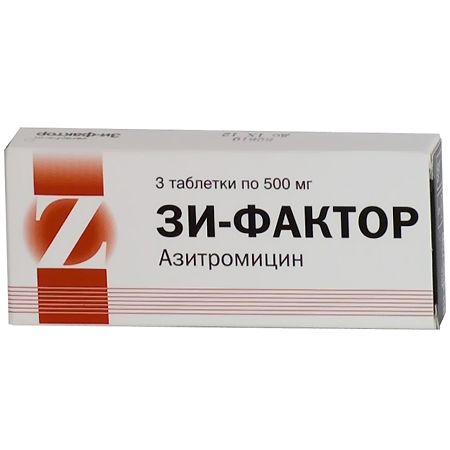No products in the cart.
Zi-Factor, 500 mg 3 pcs
€1.00
Out of stock
(E-mail when Stock is available)
Description
Zi Factor is antibacterial.
When creating high concentrations in the focus of inflammation it has a bactericidal effect.
Pharmacodynamics
The spectrum of action is broad and includes Gram-positive cocci: Streptococcus pneumoniae, Streptococcus pyogenes, Streptococcus agalactiae, Streptococcus groups CF and G, Staphylococcus aureus, Staphylococcus viridans, Gram-negative bacteria Haemophilus influenzae, Moraxella catarrhalis, Bordetella pertussis, Bordetella parapertussis, Legionella pneumophila, H. ducreyi, Campylobacter jejuni, Neisseria gonorrhoeae, Gardnerella vaginalis, some anaerobic microorganisms: Bacteroides bivius, Clostridium perfringens, Peptostreptococcus spp, as well as Chlamydia trachomatis, Mycoplasma pneumoniae, Ureaplasma urealyticum, Treponema pallidum, Borrelia burgdorferi. It is inactive against Gram-positive bacteria resistant to erythromycin.
Pharmacokinetics
Stable in acidic environment, lipophilic, rapidly absorbed in the gastrointestinal tract. After oral administration at a dose of 500 mg, Cmax in plasma is 0.4 mg/L and is reached after 2.5-2.96 h. Bioavailability is 37%.
It penetrates well into the respiratory tract, organs and tissues of the urogenital tract (in particular the prostate gland), skin and soft tissue. Concentration in tissues and cells is 10-50 times higher than in plasma, and in infection foci it is 24-34% higher than in healthy tissues (correlates with the degree of inflammatory edema).
Transported by phagocytes to the focus of infection, where it is released during phagocytosis. The apparent volume of distribution is 31.1 l/kg. High antibacterial level is maintained in the focus of inflammation for 5-7 days.
Metabolized in the liver by demethylation with the formation of inactive metabolites.
The excretion is in 2 steps; T1/2 is 14-20 h (between 8-24 h after drug administration) and 41 h (between 24-72 h).
Indications
Indications
Infections of the upper (pharyngitis, tonsillitis) and lower (bacterial and atypical pneumonia, bronchitis) respiratory tract, ENT organs (otitis media, sinusitis), skin and soft tissues (erysipelas, impetigo, secondary infected dermatoses), urogenital tract (uncomplicated urethritis and/or cervicitis), Lyme disease (treatment of erythema migrans), stomach diseases and duodenum associated with Helicobacter pylori (as part of combination therapy).
Pharmacological effect
Pharmacological effect
Zee factor is antibacterial.
When high concentrations are created at the site of inflammation, it has a bactericidal effect.
Pharmacodynamics
The spectrum of action is wide and includes gram-positive cocci: Streptococcus pneumoniae, Streptococcus pyogenes, Streptococcus agalactiae, streptococci of groups CF and G, Staphylococcus aureus, Staphylococcus viridans, gram-negative bacteria Haemophilus influenzae, Moraxella catarrhalis, Bordetella pertussis, Bordetella parapertussis, Legionella pneumophila, H. ducreyi, Campylobacter jejuni, Neisseria gonorrhoeae, Gardnerella vaginalis, some anaerobic microorganisms: Bacteroides bivius, Clostridium perfringens, Peptostreptococcus spp., as well as Chlamydia trachomatis, Mycoplasma pneumoniae, Ureaplasma urealyticum, Treponema pallidum, Borrelia burgdorferi. Inactive against gram-positive bacteria resistant to erythromycin.
Pharmacokinetics
Stable in an acidic environment, lipophilic, quickly absorbed into the gastrointestinal tract. After oral administration at a dose of 500 mg, Cmax in plasma is 0.4 mg/l and is achieved after 2.5–2.96 hours. Bioavailability is 37%.
Penetrates well into the respiratory tract, organs and tissues of the urogenital tract (in particular the prostate gland), into the skin, and into soft tissues. The concentration in tissues and cells is 10–50 times higher than in plasma, and in foci of infection it is 24–34% higher than in healthy tissues (correlates with the degree of inflammatory edema).
Transported by phagocytes to the site of infection, where it is released during phagocytosis. Apparent volume of distribution 31.1 l/kg. A high antibacterial level remains at the site of inflammation for 5–7 days.
Metabolized in the liver by demethylation to form inactive metabolites.
Removal takes place in 2 stages; T1/2 is 14–20 hours (in the range of 8–24 hours after taking the drug) and 41 hours (in the range of 24–72 hours).
Special instructions
Special instructions
It is necessary to observe a break of 2 hours while using antacids.
After discontinuation of treatment, hypersensitivity reactions may persist in some patients, which requires specific therapy under medical supervision.
Active ingredient
Active ingredient
Azithromycin
Composition
Composition
Active ingredient:
azithromycin dihydrate (in terms of azithromycin) 500 mg;
Excipients:
calcium phosphate dihydrate;
sodium lauryl sulfate;
povidone;
crospovidone;
magnesium stearate;
Shell:
hydroxypropyl methylcellulose;
titanium dioxide;
povidone;
talc;
Tween-80 (polysorbate);
acid red dye
Pregnancy
Pregnancy
Possibly if the expected effect of therapy exceeds the potential risk to the fetus.
Breastfeeding should be stopped during treatment.
Contraindications
Contraindications
Hypersensitivity (including to other macrolides), liver and/or renal failure, breastfeeding, infancy up to 1 year.
Side Effects
Side Effects
From the nervous system and sensory organs: ≤1% – dizziness, headache, drowsiness; in children – hyperkinesia, anxiety, neurosis, sleep disturbance.
From the cardiovascular system and blood (hematopoiesis, hemostasis): ≤1% – palpitations, chest pain.
From the gastrointestinal tract: diarrhea (5%), nausea, abdominal pain (3%); ≤1% – dyspepsia, flatulence, vomiting, melena, cholestatic jaundice, increased activity of liver transaminases; in children – constipation, anorexia, gastritis.
From the genitourinary system: ≤1% – vaginal candidiasis, nephritis.
Allergic reactions: rash, photosensitivity, Quincke’s edema.
Other: increased fatigue, in children – conjunctivitis, itching, urticaria.
Interaction
Interaction
Antacids (aluminum and magnesium), ethanol and food slow down and reduce absorption.
Increases the concentration of digoxin, slows down the elimination and increases the plasma concentration and toxicity of cyclosporine, indirect anticoagulants, methylprednisolone, felodipine, carbamazepine, terfenadine, hexobarbital, ergot alkaloids, valproic acid, disopyramide, bromocriptine, phenytoin, oral hypoglycemic agents, theophylline and others xanthine derivatives.
Lincosamides weaken the effectiveness, tetracycline and chloramphenicol enhance it. Pharmaceutically incompatible with heparin.
Overdose
Overdose
Symptoms: severe nausea, temporary hearing loss, vomiting, diarrhea.
Storage conditions
Storage conditions
In a dry place, protected from light, at a temperature not exceeding 25 °C
Shelf life
Shelf life
2 years
Manufacturer
Manufacturer
Veropharm LLC, Russia
Additional information
| Shelf life | 2 years |
|---|---|
| Conditions of storage | In a dry, light-protected place at a temperature not exceeding 25 °C |
| Manufacturer | Veropharm AO, Russia |
| Medication form | pills |
| Brand | Veropharm AO |
Other forms…
Related products
Buy Zi-Factor, 500 mg 3 pcs with delivery to USA, UK, Europe and over 120 other countries.
















